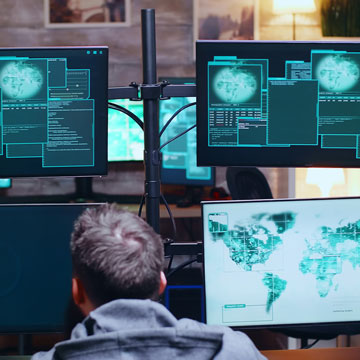
the Command Center can be interpreted as a place or location to provide orders, coordination, and rapid decision making in supporting or responding to important events.
The Command Center is a location complete with the necessary infrastructure, where a director or decision maker together with a team, to conduct meetings, make decisions, manage, monitor and control all actions needed in response to a crisis faced by the company, including emergency response actions, repair and recovery action plans, procurement steps, and public information provision steps.
Seeing the importance of the Command Center function today, many local governments, both cities and regencies, have built Command Centers to support government operations and improve services to the public. Even the Command Center is also used as one of the icons of Smart City implementation in a region.
Benefits of Command Center
Today’s Command Center has evolved from a war room to a digital interface, which provides centralized accessibility, monitoring, and control over specific organizational processes, processes or business objectives. The Command Center helps a company or organization to maintain remote control over a process or business as a whole to ensure that it is functioning as designed and not to let errors or problems continue to develop until they blow out of proportion.
Each Command Center is a centralized connection with the following three common activities:
Inbound input/communication
Process/situation report
Output/decision orders/progress reports relative to defined targets.
The centralized control over integrated sources offered by the Command Center helps to fullfill its common or consistent goals.
Types of Command Centers
There are several types of Command Centers that can be implemented properly. This definitely to strengthen and integrate between each other.
#1 Civil Management
Constantly monitor the situation and watch over the central management and control of civil operational functions. To ensure the safety of people and proper operation of essential government services while adjusting necessary services and ensuring proper constant movement.
#2 Emergency Management
In the event of a crisis, directs people, resources, and information, and controls events and occurrences to prevent a crisis/emergency and minimize/avoid impacts in the event of an incident. Acts as a central command and control facility tasked with managing emergencies and disasters at a strategic level during critical events while ensuring continuity of operations. It also serves as a support to field assets by collecting and analyzing data to develop strategic decisions that protect life and property by disseminating information to relevant departments.
#3 Security Operations Center
In most cases, the Command Center will be equipped with data processing technology to monitor and control various functions including alarms, doors, and entrance gates, while establishing control over critical information systems and access points such as databases, servers, domains, web applications, and networks. It serves as a communication hub for security personnel including law enforcement officers, airport customs, and various other institutions 24/7/365.
#4 Tactical Operation Center
This is the Command Center for law enforcement and military applications. Consisting of multiple integrated platforms incorporating data, video, and voice communication networks designed for tactical environments to provide situational awareness information to the commander and his team, the center guides members in the field and provides tactical support during missions where they track operational progress and maintain active communication with personnel in the field.
#5 Network Management
Offers centralized monitoring and maintenance of computer, telecom, or satellite networks, as a first responder for software troubleshooting, software distribution, router updates, and domain management in coordination with affiliate networks. The center also troubleshoots DDoS Attacks, power outages, network failures, and client routing systems. They trace issues/failures to their origin and resolve them without delay, ensuring a reliable network.
#6 Business Application Management
Maintain important applications for customer service and business processes available and continue to work as designed.
#7 Data Management
Important data is stored in data centers and large computer rooms are centrally managed and monitored. Such efficient command centers are designed to centrally control and monitor critical operations and ensure the performance of daily operations under various circumstances 24/7/365. Characterized as intensive work environments that require coordination of personnel and complex processes, they offer a wide range of configurations required to collect, analyze data and perform related tasks.




